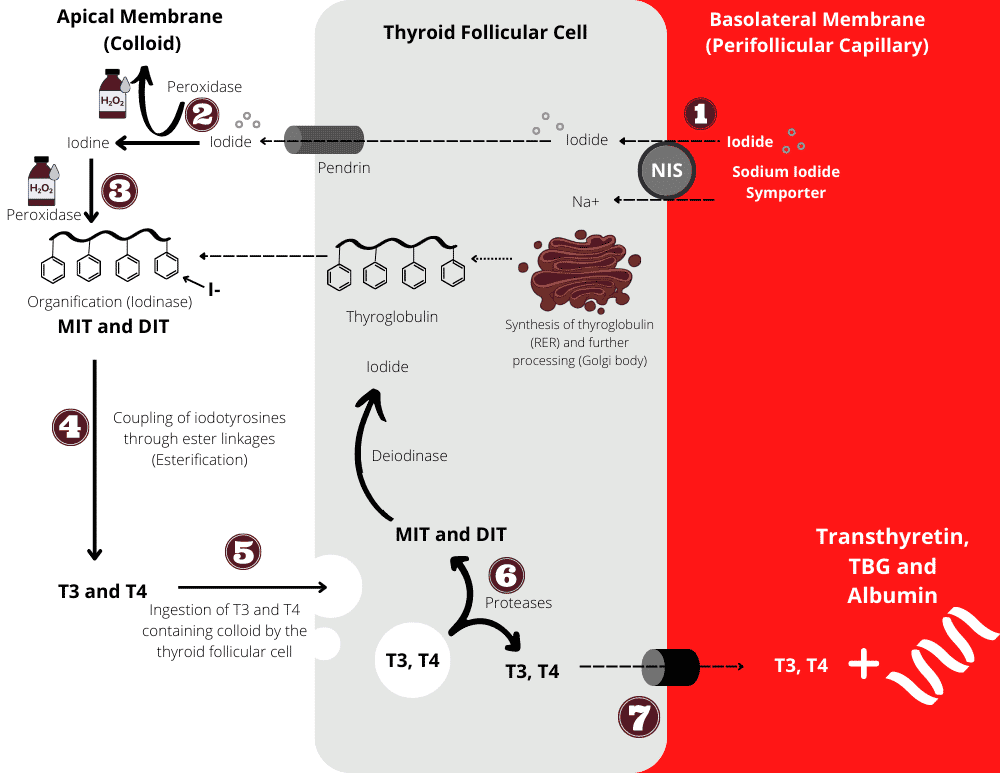
The 7 critical steps involved in the synthesis of thyroid hormone will be reviewed here. The efficient synthesis of thyroid hormone requires about 1 g of iodine per week. Indeed, iodine absorbed from the intestine travels in the blood, bound mainly to serum albumin.
At the level of the thyroid gland, sodium iodide symporters shuttle iodide from the basolateral membrane into the thyroid follicular cell.
An outline of the steps involved in thyroid hormone synthesis

(Based on Carvalho et al. (2017) Thyroid hormone biosynthesis and release. Mol Cell Endocrinol 458:6–15)
STEP 1. The sodium iodide symporters transfers iodide against a sodium electrochemical gradient (facilitated by the sodium-potassium pump), which ultimately results in an intra-follicular to plasma concentration ratio of 20 – 30 : 1.
STEP 2. At the apical membrane of the thyroid follicular cell: the thyroid peroxidase enzyme facilitates the oxidation of iodide into iodine. This enzymatic step occurs in the presence of hydrogen peroxide.
Also, thyroglobulin (Tg) is synthesized from tyrosine residues, a process that occurs in the rough endoplasmic reticulum. Subsequently, Tg undergoes further posttranslational modification in the Golgi apparatus of the follicular cell and is then secreted into the follicular lumen (site of colloid storage) through a process of exocytosis.
STEP 3 : the apical membrane of the thyroid follicular cell, oxidized iodine binds to thyroglobulin residues in an organification step facilitated by the iodinase enzyme. The replacement of hydroxyl groups on thyrosine residues (present on Tg) by oxidised iodide results in the formation of monoiodotyrosine (MIT) and diiodotyrosine (DIT).
STEP 4 : The coupling of MIT and DIT (iodotyrosines) results in the formation of tetraiodothyronine (T4, a prohormone) and tri-iodotyronine (T3, active thyroid hormone)
STEP 5: The thyroid follicular cell then ingests colloid through a process of endocytosis (also known as pinocytosis) These colloid laden endosomes then coalesce with protease containing lysosomes in the cytoplasm of the follicular cell.
STEP 6: This results in the liberation of T3 and T4 Proteolysis of the colloidal substrate in the thyroid follicular cell yields thyroglobulin, MIT, DIT, T3, and T4. Furthermore, iodinases help convert MIT and DIT into their constituent iodide and thyroglobulin subunits, which can be recycled in additional thyroid hormone synthesis.
STEP 7: T3 and T4 subsequently diffuse through the basolateral membrane of the thyroid follicular cell into the perifollicular capillary. Finally, T4 (a prohormone) is converted into active thyroid hormone T3 by deiodinase enzymes. It is worth noting that although the thyroid gland produces up to 20 times more T4 than it does T3, the latter is the more active form of thyroid hormone.
The 7 steps of thyroid hormone synthesis
This is a simple mnemonic (memory device) for recalling the 7 critical steps of thyroid hormone synthesis is SOO-3Ps (Sow Three Peas)
S : Sodium Iodide Symporter
O : Oxidation
O : Organification
3 : Esterification
P : Pinocytosis
P : Proteases
P : Peripheral deiodination
Kindly Let Us Know If This Was helpful? Thank You!


